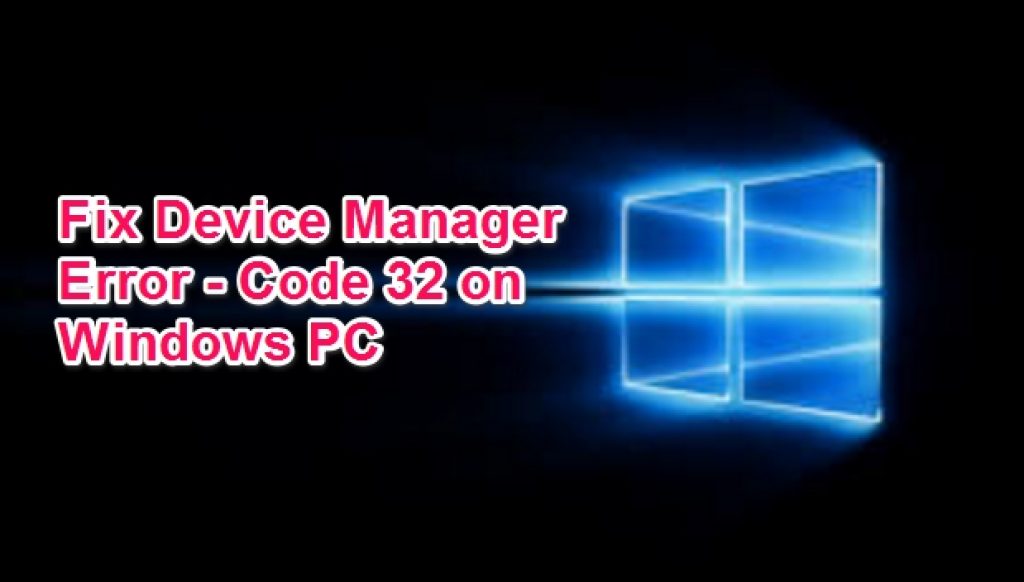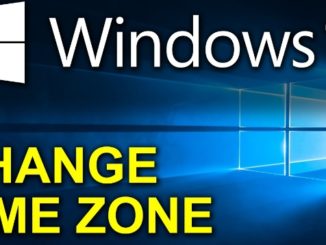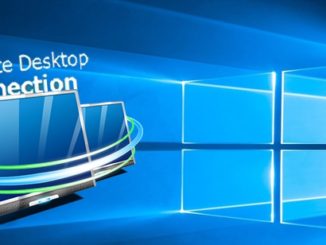Here’s how to fix Device Manager Error Code 32 on Windows PC desktop or laptop. If you are a Windows users, you must be familiar with different types of errors that pop up from time to time for known or unknown reasons. Included in these errors are System errors, Software related errors, Device Manager errors among several other errors. Every Windows error can be identified by its error code. In this post, we will focus on Device Manager Error Code 32 and how to fix it on Windows PC.
We would like to clear one thing on the onset that this ‘Device Manager Error’ is not linked to specific software related errors or the system errors. Disabled device drivers in the registry is the reason for this Device Manager Error Code 32 to pop up in Windows.
How to fix Device Manager Error – Code 32 on PC
Here’s how you can fix Device Manager Error – Code 32 on PC desktop / laptop.
- Restart PC – As is the case with any issue on Windows, first thing you should do is to reboot your device.
- If simple restart doesn’t work, undo any recent changes made to Device Manager including the software that you may have installed before which the error started appearing.
If none of the above solution worked to fix the Device Manager Error Code 32, then update your Device Drivers, fix Registry by deleting corrupt values, or change the start type in the Registry.
Update Device Drivers
Run this useful free Drivers scan utility to update device drivers to check if the problem is with PC drivers.
If the scan show no issue with the device drivers on your Windows device, the next steps requires you to inspect Registry. Do note that you need to have good knowledge of how to edit system Registry file before proceeding as it involves tinkering with system files which could cause further issues in case of any mistake. To make the life easier for you, download Registry Cleaner Tool that will clean Registry from corrupted values automatically.
Delete UpperFilters & LowerFilters Values In Registry
To start off, when you first enter the Registry editor on Windows device, delete the UpperFilters and LowerFilters Registry values. These registry values contain information regarding Windows installation. You can find these registry values under Registry Keys in the Windows Registry Editor.
To help you understand better, the UpperFilters relate to the Operating System and the relevant Driver, and the LowerFilters relate to the Drive and the relevant hardware such as printer, DVD player, sound and others. Here’s how to fix it:
1 – Press Windows Key + R to open RUN dialogue box.
2 – Type regedit in the RUN box to open Registry editor window.
3 – In the Registry Editor, under My Computer, find the HKEY_LOCAL_MACHINE option and click the + sign next to it to expand the list.
4 – Now head over to HKEY_LOCAL_MACHINESYSTEMCurrentControlSetControlClass where you will see a list of subkeys with 32-digits.
5 – Select the GUID Subkeys to confirm which of the Global Unique Identifiers (GUIDs) are causing the problem.
6 – After finding the GUID causing driver error, click on the registry subkey next to that GUID.
7 – Now, locate the UpperFilters and the LowerFilters values on the right-pane of Registry window.
8 – Right-click on the UpperFilers value and select Delete.
9 – Click on YES when asked for confirming your selection.
10 – Repeat the above steps to delete LowerFilters values (leave values with .bak extension as it is).
11 – Close Registry Editor window and restart PC.
That should be enough to fix the Device Manger error code 32 on Windows. See a list of GUID subkeys for easy reference. Note that some of the values may be different on your Windows PC.
4D36E965-E325-11CE-BFC1-08002BE10318 – CD/DVD/Blu-ray drives
4D36E967-E325-11CE-BFC1-08002BE10318 – Hard drives
4D36E968-E325-11CE-BFC1-08002BE10318 – Video adapters
4D36E96A-E325-11CE-BFC1-08002BE10318 – Hard drive controllers
745A17A0-74D3-11D0-B6FE-00A0C90F57DA – Some USB devices
6BDD1FC1-810F-11D0-BEC7-08002BE2092F – IEEE 1394 host controller
6BDD1FC6-810F-11D0-BEC7-08002BE2092F – Cameras and scanners
4D36E96B-E325-11CE-BFC1-08002BE10318 – Keyboards
4D36E96D-E325-11CE-BFC1-08002BE10318 – Modems
4D36E96F-E325-11CE-BFC1-08002BE10318 – Mouse devices
4D36E96C-E325-11CE-BFC1-08002BE10318 – Audio and video devices
4D36E972-E325-11CE-BFC1-08002BE10318 – Network adapters
4D36E978-E325-11CE-BFC1-08002BE10318 – Serial and parallel ports
4D36E97B-E325-11CE-BFC1-08002BE10318 – SCSI and RAID controllers
36FC9E60-C465-11CF-8056-444553540000 – USB host controllers and hubs
Change Driver’s Start Type
If the method above failed to solve the problem, then you can try to manually change the faulty driver’s start type in the registry. Those of you who are not familiar with Registry editor can use a Registry Cleaning Tool to perform the tasks automatically.
Click on the official Microsoft link to find the necessary information requirement regarding changing the start type of Drivers.
And finally, if none of the solution above worked to solve the problem, the only way to fix device manager error is to replace hardware. This should be used as a solution of last resort as replacing hardware could be costly and requires time and effort. What do think about it? share in the comments below.
Also Check Out On AppsforWin10:
Top 10 Best Music Manager & Downloader Apps for Windows
How To Fix ‘Server DNS Address Could Not Be Found’ Error in Chrome for Windows
Driver Power State Failure on Windows 10, Windows 8/8.1
How To Fix Keyboard Not Responding In Edge Browser & Start Menu On Windows 10




